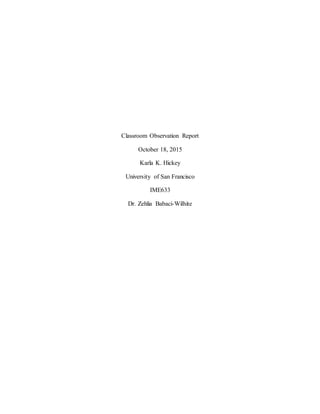
Classroom Observation Report
- 1. Classroom Observation Report October 18, 2015 Karla K. Hickey University of San Francisco IME633 Dr. Zehlia Babaci-Wilhite
- 2. Introduction Mr. Shawn D. Wolfe an English Language Acquistion instructor at the Garnet Career Center in Charleston, West Virginia is the individual chosen for this classroom observation assignment. His title is Program Developer and Instructor, he has eight years of experience in the United States and abroad. The Capital City Engage ELA program and curriculum is his vision. Teaching Context Students range in age from 25 to 55. Interests are literacy, career development and post-secondary education. Levels of proficiency range from beginner to low intermediate. However, one student is a reading beginner, yet quite advanced in listening and speaking. According to Wolfe, “every student has an aptitude to learn a language.” (Wolfe 2015) Academic an educational level ranged from no formal schooling to high school. Students were motivated, cooperating and intrigued. The classroom provided a safe, comfortable environment, stuednts were comfortable and participated readily. Students feel comfortable wearing traditional clothing. Classes reflect background culture and allow student to make connections to West Virginia and the United States. Two instructors are responsible for a myriad of roles. One instructor is full time the other part time/full time. At this time 68 students are enrolled. Management appears to be centrally located. Wolfe feels his responsibilities are increasing while he is losing autonomy. Technology is adequate, however, support is centrally located. Support personnel have shared responsibilities and are impractical to utilize. Findings from Lesson Discussion with Teacher This particular lesson was an impromptu lesson which reflects the instructors knowledge of sociocultural theory. The topic was straight forward and connected the students to a common interest, Chinese food. The interest was tied to culture. There was no script therefore, students developed creative strategies. Students collaborated and adapted strategies as their experience increased. Everyone accomplished the goal, although in their own time and style. With this type of lesson and a diverse group you can not predict how the lesson will unfold. Teacher facilitates students, with encouragement and becomes a participant. Thus, an authentic dialogue is effortlessly produced. Overview of the Lesson Observed Mr. Wolfe is seated with a small group of students. He begins with a discussion of Chinese food and asks the student if they have ever eaten with chopsticks. Students share experiences and he then begins to demonstrate how to hold chopsticks. Students begin to practice. As students progress they are laughing and talking. The lesson progresses as students
- 3. are asked to begin to simulate use of the utensil by picking up an eraser and dropping it in a cup. One student is from China and he demonstrates that his particular way of holding chopsticks is different than the demonstration. Students are then encouraged to try both ways. Students again attempt to pick up eraser and put them in the cup. Each student acoomplished the goal in their own unique style. Classroom Observation Findings Students were seated at a table in a group. Instructor was seated facing students as a group member. The instructor initiates a discussion. Students immediately contribute and are engaged. The tone of the classroom was relaxed yet focused. Students connected with the topic and offered responses which soon connected them in a commonality of experience. Each student contributed background information regarding their type of utensil and their experience with chopsticks. Each student had eaten Chinese food. Students were able to demonstrate their mastery of chopsticks and accomplish the task. During a unit on food this lesson was developed in an impromptu manner.Students were asked to discuss food and become awared food is cultural. The role of the teacher was flexible, he would demonstrate, model and encourage, then become an active participant. He practiced the task with the method another student demonstrated. Students we encouraged to try both methods as well. Teacher talking time was offered to discuss and relate the context of the lesson, however as the lesson progressed the instructor became a partipant. Students began to help each other. No signs of frustration were evident. Encouragement, suggestions and authentic conversation began to evolve. Students were to demonstrate mastery of chopsticks by picking up an erase and dropping it in a cup. I feel this lesson demonstrated commonality, shared culture and demonstration of feedback. One student noted she would attempt to utilize chopsticks the next time she ate Chinese food. Suggestions for Lesson Improvement One of the students was an expert. Possibly this student could have been utilized to demonstrate and assist students. He could have been given another activity to keep him engaged. Students might have been asked to include utensils from their country. Wolfe is a proponent of sociocultural learning. This lesson encourages community building, encourages self efficacy and confidence. It is sociocognitive in the sense of listening seques into trying. Connections were made and the activity was inclusive of the identity of participants. Students were happy, laughing and asked questions. Authentic conversation and use of the lesson vocabulary was accomplished.
- 4. Referenced McDonough, J., Shaw, C., Masuhara, H. (2013). Materials and methods in ELT: A teacher’s guide (3rd edition). Wile -Blackwell.